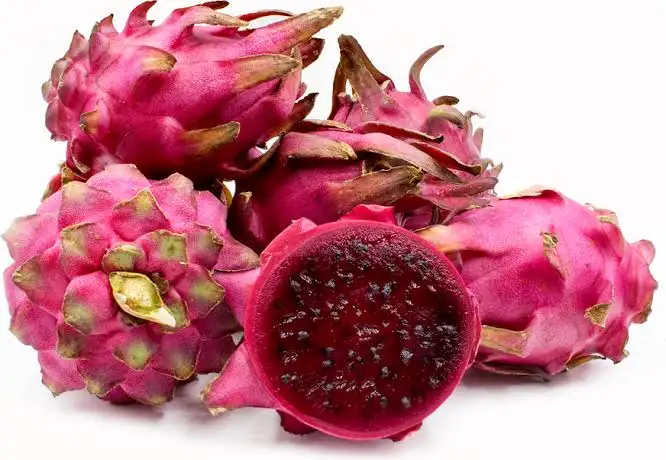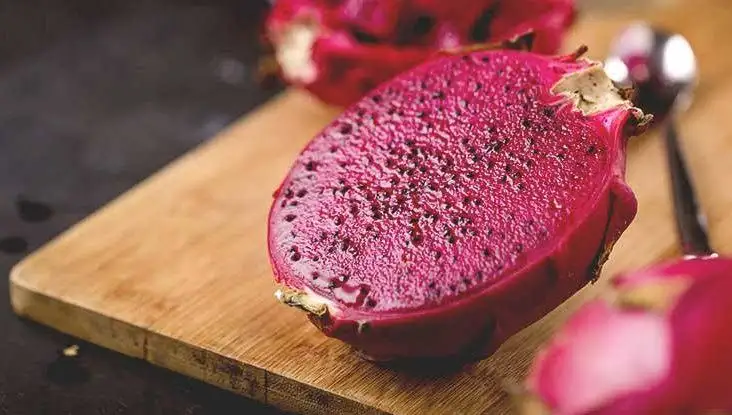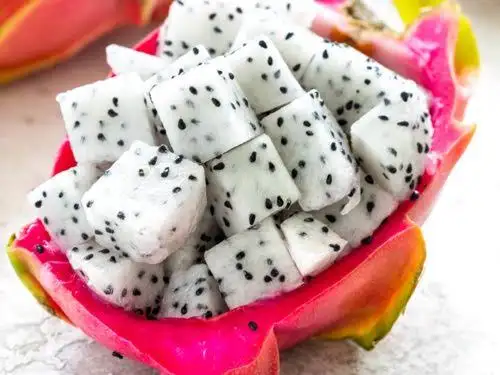Dragon fruit, also known as Pitaya or Pitahaya, is a member of the cactus family, and is botanically found in two separate genera: Hylocereus and Selenicereus. However, the most commonly cultivated varieties are in the genus, Hylocereus, including the white-fleshed fruit, Hylocereus undatus. The Dragon fruit plant has also been nicknamed Belle of the Night, Cinderella plant, Night Blooming Cereus, Queen of the Night, and Moonflower, as its flowers only bloom for one night each year. During the short window overnight, the large, extremely fragrant flowers are pollinated by moths, bats, or by hand, although some varieties can self-pollinate. Despite the short-lived flowers, the plant will bear fruit about 4-6 times each year.
Dragon fruit grows on climbing cacti with stems that reach up to 6 meters long. The fruits are oval to oblong in shape, weighing about 8-12 ounces and averaging 10-15 centimeters in length. They have a pink or magenta peel with green scale-like leaves, and white flesh that is dotted with tiny edible black seeds, similar to a kiwi. The juicy, spongy yet dense pulp offers a subtle sweet flavor with notes of berry, pear, kiwi, and watermelon, sometimes with just a hint of sourness. Here are some of the popular Varieties of Dragon Fruit:
- Sour Dragon Fruit
- White Dragon Fruit
- Red Dragon Fruit
- Yellow Dragon Fruit
- Pink Dragon Fruit
- Chinese dragon fruit
- Israeli Yellow pitaya
Yellow Dragon Fruit

Botanically known as Selenicereus megalanthus or Hylocereus megalanthus, the fruits are also known as Yellow pitahaya itaya Amarillo. Yellow Dragon fruit have an oblong shape and are slightly smaller in size than the more common red varieties. Their thick yellow skin is covered in small knobby protrusions, which when immature displays small spines that will naturally fall off as the fruit matures. Beneath the skin is a dense white flesh containing numerous petite, edible black seeds. Yellow Dragon fruit has a crisp, juicy texture and very sweet, tropical flavor with floral hints and no acidity.
White Dragon Fruit

White dragon fruit grows on climbing cacti with stems that reach up to 6 meters long. The fruits are oval to oblong in shape, weighing about 8-12 ounces and averaging 10-15 centimeters in length. They have a pink or magenta peel with green scale-like leaves, and white flesh that is dotted with tiny edible black seeds, similar to a kiwi. The juicy, spongy yet dense pulp offers a subtle sweet flavor with notes of berry, pear, kiwi, and watermelon, sometimes with just a hint of sourness.
Also Read: Different Types of Pineapples Fruits
Pink Dragon Fruit

Pink dragon fruits grow on long, thin, vining cactuses that are often seen growing up trees, fences or walls. On the outside, Pink dragon fruits look almost identical to the white-fleshed variety. The brightly colored oblong fruits are about 10 centimeters in length and can weigh up to a pound. They have pink to magenta-colored skin that has the appearance of succulent, fleshy scales overlapping, leaving small, green-tipped protrusions along its length.
The skin is thin, with an average thickness of only 3 millimeters, so the flesh to rind ratio is high. The bright magenta flesh of the Pink dragon fruit is the result of a compound called betacyanin, which is the same pigment present in beets and prickly pear fruit. The pulp has the texture of a kiwi fruit, with small, black edible seeds throughout.
Red Dragon Fruit

Red Dragon fruits are small to medium-sized varietals, averaging 4 to 9 centimeters in diameter, and have an oval to oblong shape. The fruit’s skin ranges in color from bright pink, fuchsia, to red-brown, and is semi-smooth and waxy, covered in fleshy, overlapping scales that showcase green tips. The curvy scales have a triangular shape, and Red Dragon fruit varieties typically have narrower scales.
The thin skin can be easily peeled once sliced, revealing a dark red to crimson flesh containing many tiny, black, edible seeds. The flesh has a dense, semi-firm, and tender, aqueous consistency, contrasted with the crunchy, chewy seeds, creating a texture similar to kiwi fruit. Red Dragon fruit has little to no aroma and should appear taut, shiny, and brightly colored when ripe. The flesh has a delicate, sweet, earthy, and mildly acidic flavor combined with a faint nuttiness from the seeds.
Israeli Yellow Dragon Fruit

Israeli Yellow pitaya, or Yellow Dragon fruit, was developed over a span of several decades by botanists at Ben-Gurion University of the Negev, in Beer-Sheva, Israel. The Israeli Yellow pitaya is a clone of the red fruited Hylocereus undatus and it has characteristics more akin to the red-skinned pitaya. Israeli Yellow pitaya are rounded fruits with an elongated shape and measure between 9 and 12 centimeters long and 7 to 10 centimeters wide.
The Israeli Yellow pitaya does not have spines, instead, the thick skin is covered in the same soft bracts or scales as the red-skinned varieties. The fleshy protrusions growing outwards from the surface of the fruit are tipped with green. Within the fruit is a dense, translucent to white flesh speckled with numerous small, black edible seeds. Israeli Yellow Pitaya offer a juicy texture and sweet, tropical flavor, reminiscent of kiwi or pear.
Also Read: Major Types of Bananas To Grow At Home
Chinese Dragon Fruit

Chinese Dragon Fruit is a hybrid dragon fruit variety, botanically known as Hylocereus constaricensus and sometimes Hylocereus polyrhizus. Chinese dragon fruit are oval to oblong in shape, a larger variety dragon fruit, it weigh about 75-1.5 pounds. They have a thin magenta-pink peel that have overlapping succulent scales that are tipped with green. Its purple-pink flesh is embedded with several edible black seeds. The texture is similar to that of the kiwi and the flavor is sweet, with mild acidity. Chinese Dragon Fruit is also referred to as Physical Graffiti dragon.
Sour Dragon Fruit

Stenocereus fruit (sour pitayas) are a variety that is commonly eaten in the arid regions of the Americas. They are more sour and refreshing, with juicier flesh and a stronger taste. The brightly colored oblong fruits are about 10 centimeters in length and can weigh up to a pound. They can have, white, red, yellow, pink to magenta-colored skin that has the appearance of succulent, fleshy scales overlapping, leaving small, green-tipped protrusions along its length. The skin is thin, with an average thickness of only 3 millimeters, so the flesh to rind ratio is high. The pulp has the texture of a kiwi fruit, with small, black edible seeds throughout.
How to grow a Dragon Fruit
As a tropical species, dragon fruit needs warmth, moisture and plenty of light to thrive. Choose a garden bed with full sun or light shade during the hottest part of the day and deep, organically rich soil with good drainage. Dragon fruit needs a very sturdy support structure such as a freestanding trellis or pergola to support their mature size, which can exceed 20 feet. Plant dragon fruit at least 15 to 25 feet away from structures, power lines and trees to prevent damage.
Dragon fruit can withstand periods of drought, but it needs regular watering during the growing season to produce fruit. During the late winter and early spring months, it needs slightly drier soil to induce flowering. To provide nutritional support, feed dragon fruit weekly during the active growing season with 1/2 teaspoon of 20-20-20 fertilizer diluted in 1 gallon of water.